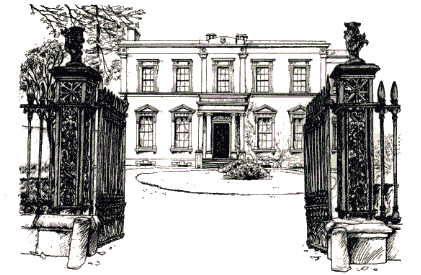

ST. GEORGES TERRACE AND HATLEY MANOR
St. George's Terrace, which leads from the Town Clock to the old Courthouse reminds us of the long association of the town with the St. George family. After we pass the Post Office and the premises of the Leitrim Observer, Leitrim's only newspaper, we meet a terrace of four houses. These are a good example of the type of house built in Carrick in the 19th Century. The arched doorway is a feature of many of the houses, especially in Main Street.
In the list of names of members who served in the Irish Parliament for the Borough of Carrick-on-Shannon from 1613 to 1800 the name that occurs most frequently is that of "St.George".
Hatley Manor, the Carrick-on-Shannon home of the St.George family and later of the descendants, the Whyte family, was erected in the 1830's. The name "Hatley Manor" comes from Hatley St.George, the ancestral home of the family in Cambridgeshire, England. This fine mansion is now the home of the Flynn family.
The old Courthouse was built in 1821, the Architect being William Farrell, who also designed Colebrook House, Co. Fermanagh, the residence of Lord Brookborough, former Prime Minister of Northern Ireland. It is not now seen to best advantage as the removal for safety reasons of four massive Doric pillars and the rest of the portico has left it with a rather bare appearance.
Since its erection it has been the centre of local government and administration for Co. Leitrim. The Grand Jury for Co. Leitrim held its meetings here and since 189 it has housed the chamber and offices of Leitrim County Council. The District and Circuit Courts are also held there. An underground tunnel, which still exists, led from the courtroom to the nearby jail, so that convicts could be conveyed straight from the dock to serve out their sentence, or worse still, to the place of execution without any chance of interference on their behalf.
Of all the sights seen by Carrick Courthouse in its long history, probably the most tragic was the occasion in 1921 when the bodies of the Volunteers killed by the British forces at Selton Hill were brought here. The Crown forces were in occupation of the Council premises as well as the nearby jail.
Until its demolition in 1968 the great hulking mass of Carrick Gaol was a grim reminder of the severity of the penal system in the past, especially in dealing with what was euphemistically known as "disaffection". Its construction was begun in 1815 and it was finally completed in 1822. It was almost totally surrounded by the waters of the Shannon, so that no prisoner could contemplate escape unless he was a strong swimmer. The Jail had 80 cells, seven "black holes" for solitary confinement, a condemned cell, a treadmill, fourteen work rooms and special apartments for debtors. There was also a hospital, and two places of worship, probably Protestant and Catholic. The Governor's House and some other remaining jail buildings are now occupied by the Engineering Staff of Leitrim County Council.
The last execution took place about 1847 when Hugo Kelly, believed to be a member of the secret agrarian society "The Molly Maguires" was hanged. During the War of Independence 1919-1921 a British Officer named Captain Cyril Crawford "condemned" Darrell Figgis and Peadar Keaney to be hanged. He even ordered rope for the purpose, but another officer intervened and Keaney and Figgis were set free.
Sir George St.George, the MP in 1639, was granted the highest honour of the Kingdom of Sweden when he travelled there to act as emissary of King Charles I. His task was to confer the Order of the Garter on King Gustavus Adolphus. In addition to the honour, he was given a cup of finest London silver (marked 1597) which is still extant.

THE OLD COURTHOUSE AND GAOL

The demolition of Carrick Jail made way for the construction of the modern Marina (where the sculpture on the right stands), which is one of the outstanding amenities of present-day Carrick. This surely is a fine example of "beating swords into ploughshares" and what was once a place of bondage and suffering is now a centre of pleasure and recreation.

